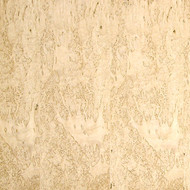Karelian Burl wood comes from the burl formations of the Karelian Birch tree (Betula pendula var. carelica), a unique variety of Silver Birch that grows primarily in the Karelia region, which spans parts of Finland and Russia. This wood is prized for its exquisite grain patterns, natural luster, and rarity. Karelian Burl has been used historically in fine art, furniture, and luxury goods, often symbolizing elegance and exclusivity.
Characteristics of Karelian Burl Wood:
- Grain Patterns:
- The wood is renowned for its highly figured grain, which includes swirling, wavy lines, and clusters of "eyes" typical of burl wood.
- The intricate patterns give the wood a marbled, almost three-dimensional appearance.
- Color:
- Karelian Burl typically features light creamy to golden hues with darker brown or gray streaks.
- Its contrast and color depth can vary, creating a visually striking effect.
- Texture:
- The wood has a fine, smooth texture that takes polishing exceptionally well.
- Its natural luster enhances the visual appeal of the grain.
- Durability:
- Karelian Birch Burl is moderately hard and durable, making it suitable for a variety of applications.
- However, the irregular grain can make it more prone to cracking or splitting if not handled carefully.
- Rarity:
- Karelian Burl is considered rare due to the limited range of the tree and the sporadic occurrence of burls, making it a highly sought-after material.
Uses of Karelian Burl Wood:
- Furniture and Veneers:
- Often used as a veneer for high-end furniture, including tabletops, cabinets, and decorative panels.
- Adds a luxurious and sophisticated touch to interiors.
- Luxury Goods:
- Frequently used in the creation of high-end pens, knife handles, jewelry boxes, and other decorative items.
- Musical Instruments:
- Used for crafting decorative elements on guitars, violins, and other string instruments.
- Artistic Projects:
- Ideal for sculptures, plaques, and custom art pieces due to its unique and dramatic appearance.
- Historical Significance:
- Karelian Burl has been used in royal furniture and art pieces, symbolizing wealth and prestige.
Challenges:
- Workability:
- The irregular grain of Karelian Burl can make it challenging to cut and shape, with a risk of tear-out.
- Stabilization or resin infusion may be required for pieces with natural voids or cracks.
- Cost:
- The wood is relatively expensive due to its rarity, high demand, and association with luxury.
- Environmental Impact:
- Harvesting is limited to ensure sustainability, as the Karelian Birch tree is not widely distributed.
Why It's Valued:
Karelian Burl wood is treasured for its exceptional beauty, rarity, and historical significance. The intricate grain patterns and warm tones make it a prized material for high-end woodworking and luxury creations. Its exclusivity and connection to the Karelia region further enhance its allure, making it a symbol of refinement and craftsmanship in both historical and modern contexts.


